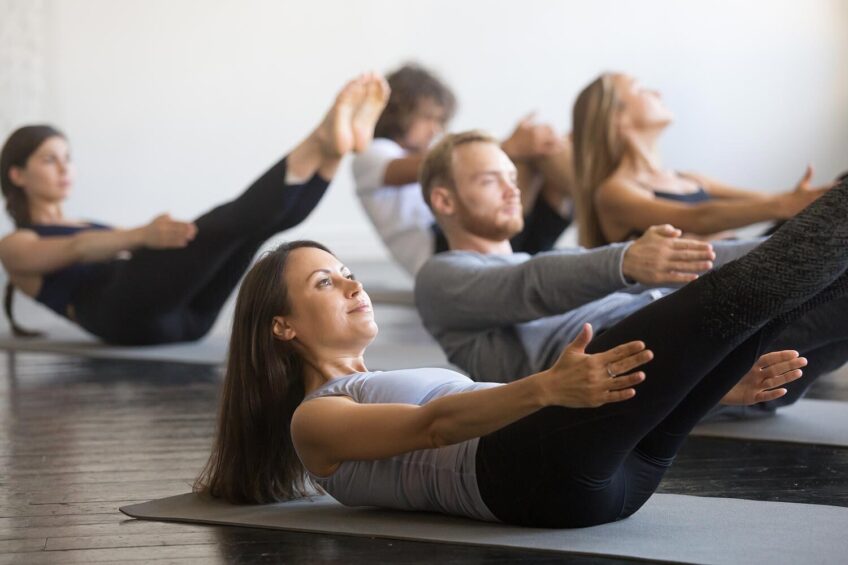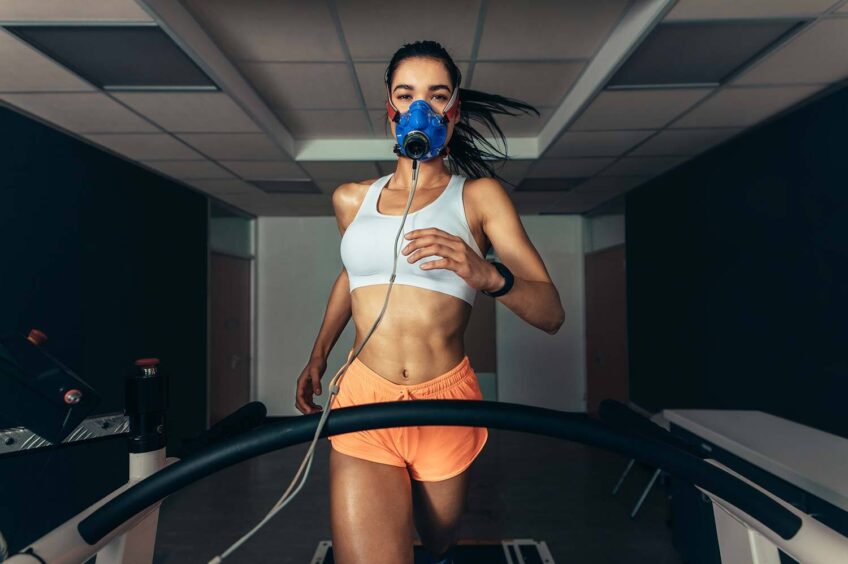How Do You Breathe Properly When Running for Maximum Efficiency?
Breathing correctly while running has many fitness benefits. Maximize your fitness levels through breath control and specific exercises.

When you’re working on building running endurance and overall fitness, it feels like most of your body hurts. It can be hard to get enough air into your lungs, your legs feel like they’re burning, and before you’ve run a mile, you might already have slight muscle aching. I hope it’s not just me that goes through this on a semi-regular basis, even though I’ve been running for a while!
A couple of months back, I was tired of trying to up my speed and distance and feeling like my lack of lung capacity was holding me back.
I decided to take action and do a deep dive into the research and chat with a few running coaches that I highly respect. And they all said the same thing: it all comes down to your diaphragm, and believe it or not, your diaphragm is the key to taking your running to the next level, regardless of whether you’re a beginner, a pro, or somewhere in between.
Breathing is the powerhouse that controls the movement of oxygen to your muscles, and by improving your breathing, you can make it easier to progress quicker, and soon you’ll be running faster and longer.

If you’re new to running and not sure what I’m talking about, it’s that feeling you get of not being able to get enough air no matter how deep or often you breathe in and out.
Or when you have to break up your run intermittently, even if you’re not tired so that you can walk and have a moment to catch your breath. Sound familiar?
Then slower, deeper breathing is going to improve your running because it’s a more effective way to get oxygen to the muscles (and you’ll use less energy in the process).
How does breathing work?
As you breathe in, oxygen-rich air travels down the trachea, into your two bronchi tubes and then into smaller tubes (your bronchioles), and further down into your alveoli, which are microscopic sacs in your lungs. You have around 480 million of these, and they deliver oxygen into the blood via a diffusion process.
There is no way to improve the number of alveoli through running, but you can improve the strength of your diaphragm and intercostals so that you can draw more oxygen into your lungs with each breath.
If you’ve been running for a while, you’ll notice that there’s a shift that happens as you start running where you go from an at-rest breathing state (breathing through your nose) into a more active state where you switch to mouth breathing to draw in the air more effectively.
As the run progresses, you’ll start taking breaths more frequently because your muscles demand more oxygen and your lungs take in four to eight times more air than when you are at rest.
So how do you breathe when you run if you want to go faster (and further)?
Your diaphragm does 80 % of the work of breathing, so it stands to reason that if you can strengthen your diaphragm, you will be able to go further (and faster) without getting tired.
Research by the Centre for Sports Medicine and Human Performance at Brunel University found a direct link between breathing effort and leg fatigue in marathon runners. In other words, the harder the diaphragm and intercostals had to work, the more strain the runner’s legs would take.
To prevent this, you need your breathing muscles to be stronger, and the key is to breathe deeply. Deep breaths get more air into the alveoli, which diffuses more oxygen into the blood. There are three steps to breathing correctly (and more effectively) when running:
Step 1 - Keep your mouth open
Your mouth is more effective at taking in oxygen than your nose because it is larger. Mouth breathing also makes it easier to take deep breaths and keeps your face relaxed.
Step 2 - Focus on pattern breathing
The easiest way to start is to coordinate your breathing with your steps. This is progressive, and you can start with a 2:2 pattern, breathing in for two steps (left, right) and out for two steps (left, right). As you build diaphragmatic strength, you can move to 3:3 and even 4:4 breathing.
Step 3 - Use Pilates to strengthen the diaphragm
These three effective Pilates moves can be done a couple of times a week, preferably before your run:
- The Hundred - this teaches controlled breathing where you earn to balance your inhale and exhale (this is my worst Pilates move, I can never seem to get to 100!)
- The Swan - this exercise helps to open up the chest and improve lung capacity, effectively correcting shallow breathing.
- The Chest Expansion - this stretch activates the intercostals, diaphragm, and pelvic floor, as well as relaxing the shoulders and balancing your breathing.

What are some of the common breathing issues?
The most common breathing issue (and most runners struggle with this), is chest breathing rather than belly breathing. To test whether this is something you’re getting wrong, take a brisk jog for a mile or so, then place one hand on your chest and the other on your abdomen. The upper hand (on your chest) should remain relatively still, while the other should move with every breath as your belly fills up like a balloon with air.
In addition to being a less efficient way of getting oxygen to your muscles, chest breathing also increases tension in the shoulders, which can cause pain and makes them move up and down as you run.
What are some effective breathing exercises for running?
1. Find a Good Pace
If you’re new to running, there’s a good chance you’re gasping for air before you’ve even run a mile, and as that happens, your body’s stress response takes it up a notch, causing your body to panic and struggle with breathing even more.
The best way to counteract this is to slow down. A good rule of thumb is to run at a pace that allows you to speak a few words (you don’t have to be able to keep up a full conversation), and you can break up the run with walks if you need.
If you can commit to training consistently, your body will get better at delivering oxygen to your muscles, and you’ll learn to run for longer without feeling chronically short of breath.
2. Practice While You Run by Counting Steps
This is the pattern-breathing I mentioned above. If you have a good level of running fitness, you can start thinking about breathing in rhythm to control how often and how deep you breathe. This will help you breathe more efficiently and will have a direct impact on your running performance.
Starting with 2:2, breathing will help you pace yourself and ensure that your muscles are getting enough oxygen. You can practice on a walk or a shorter run, and as you get more comfortable, you can incorporate it into faster runs.
You can take pattern-breathing one step further and train your diaphragm by pairing the 2:2 breathing method with stride counting. You could have a goal of counting to 100, and as you reach the goal, you start from 1 again.
This is my preferred method of breathing while running. It's also a great way to help me get out of my head with ruminating thoughts when I struggle to push through the next mile!
3. Practice Belly Breathing
This is where you want to focus. If you can take five minutes a day in the morning or the evening to practice belly breathing, you’ll quickly make progress when you run.
Lie down on your back and place one hand on your stomach, then take slow deep breaths that alternatively lift your hand as you inhale and sink it as you breathe out. You can place your other hand on your chest to check that it isn’t moving.
Once you feel like you’ve got it mastered, try practicing when walking around and then integrate the technique on your runs.
4. Focus on a Natural Exhale
With so much focus on breathing in, it can be easy to forget about the exhale. While your blood is busy transporting oxygen to your muscles, it’s also picking up carbon dioxide waste which is just as important.
So, what does that mean for your exhale? Should you breathe out as hard as possible? No.
The exhale is a more passive process powered by your diaphragm springing back into neutral, so it should feel natural rather than forcing out a breath which stimulates a greater need to breathe in again.
How can you tell if you’re breathing correctly?
These are tell-tale signs that you’re not breathing correctly and your diaphragm isn’t working efficiently:
- You’re gasping for air.
- You have tightness in your neck or back.
- Your shoulders move up and down as you run.
Also, there are ways to actually measure your breathing efficiency -- the unit of measurement is known as VO2. This is the maximum volume (V) of oxygen (O2) your body can process.
Increasing your VO2 will increase your fitness level output. VO2 is the combination of your heart volume and lung capacity, muscle efficiency, and capillary delivery.

Many fitness centers offer VO2 testing, and this is a common laboratory test for athletes. If you have access to that testing and you're an active runner, I encourage you to get the test.
However, for the majority of people, most fitness watches will calculate your VO2 exceptionally well.
According to the Fitness Registry and the Importance of Exercise (FRIEND), the numbers below represent the optimal percentile values by age and gender.
| Age Group | 5th PCTL | 10th PCTL | 25th PCTL | 50th PCTL | 75th PCTL | 90th PCTL | 95th PCTL |
|---|---|---|---|---|---|---|---|
| Men | |||||||
| 20-29 | 29.0 | 32.1 | 40.1 | 48.0 | 55.2 | 61.8 | 66.3 |
| 30-39 | 27.2 | 30.2 | 35.9 | 42.4 | 49.2 | 56.5 | 59.8 |
| 40-49 | 24.2 | 26.8 | 31.9 | 37.8 | 45.0 | 52.1 | 55.6 |
| 50-59 | 20.9 | 22.8 | 27.1 | 32.6 | 39.7 | 45.6 | 50.7 |
| 60-69 | 17.4 | 19.8 | 23.7 | 28.2 | 34.5 | 40.3 | 43.0 |
| 70-79 | 16.3 | 17.1 | 20.4 | 24.4 | 30.4 | 36.6 | 39.7 |
| Women | |||||||
| 20-29 | 21.7 | 23.9 | 30.5 | 37.6 | 44.7 | 51.3 | 56.0 |
| 30-39 | 19.0 | 20.9 | 25.3 | 30.2 | 36.1 | 41.4 | 45.8 |
| 40-49 | 17.0 | 18.8 | 22.1 | 26.7 | 32.4 | 38.4 | 41.7 |
| 50-59 | 16.0 | 17.3 | 19.9 | 23.4 | 27.6 | 32.0 | 35.9 |
| 60-69 | 13.4 | 14.6 | 17.2 | 20.0 | 23.8 | 27.0 | 29.4 |
| 70-79 | 13.1 | 13.6 | 15.6 | 18.3 | 20.8 | 23.1 | 24.1 |
Interval training is one of the best ways to improve your VO2 and breathing overall. Get on your treadmill and run for 2-3 minutes at a high pace, then jog for 2-3 minutes at a very relaxed pace. Repeat the process (or interval) for 20-30 minutes.
My thoughts?
I’ve worked hard on my belly breathing over the years, which is why I have first-hand experience with the Hundred Pilates exercise (and we’re definitely not friends). It’s one of the best exercises if you want to up your control, but man, it burns!
I’m somewhere in the middle of my breathing journey, having incorporated counting into my runs, and I’ve also been working on getting my diaphragm strength up.
But I know I have a long way to go, and 2:2, maybe 3:3 on an easy run is about as good as it gets for me. I’ve also found it helpful to focus predominantly on getting my inhale right, leaving my exhale to sort itself out.
Tony Lee, MS, RD
Tony Lee, RD, MS, is a highly qualified and accomplished Registered Dietitian with a Master’s Degree in Nutrition Sciences. Tony brings over two decades of experience in dietetics, specializing in sports nutrition. Interests include studying all aspects of wellness, fitness, genetics, and peak health performance.










